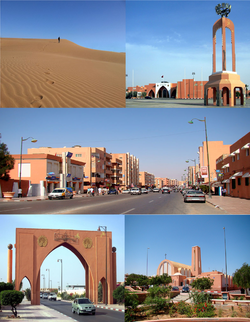Top Qs
Timeline
Chat
Perspective
Laayoune
Largest city of Western Sahara From Wikipedia, the free encyclopedia
Remove ads
Laayoune[a] or El Aaiún[b] (Arabic: العيون, al-ʕuyūn [alʕujuːn], Hassaniyya: [ˈləʕjuːn] ⓘ, lit. 'The Springs') is the largest city of the disputed territory of Western Sahara, with a population of 271,344 in 2023.[7] The city is the de jure capital of the Sahrawi Arab Democratic Republic, though it is under de facto Moroccan administration as occupied territory. The modern city is thought to have been founded by the Spanish captain Antonio de Oro in 1938.[8] From 1958, it became the administrative capital of the Spanish Sahara, administered by the Governor General of Spanish West Africa.[9]
In 2023, Laayoune is the capital of the Laâyoune-Sakia El Hamra region administered by Morocco, it is still under the supervision of MINURSO, a UN mission.
The town is located south of the dry river of Saguia el-Hamra, where the old lower town constructed by Spanish colonists is located.[10] The St. Francis of Assisi Cathedral was constructed during the Spanish period and is still active with a few Catholic missionaries.
Remove ads
History
Summarize
Perspective
Laayoune or El Aaiún are respectively the French and Spanish transliterations of one of the possible Romanized Maghrebi Arabic names for the city: Layoun, which could mean "the springs", in reference to the oases that furnish the town's water supply.[11]
The city was founded by the Spanish captain Antonio de Oro in 1938 as a small military outpost, but quickly became the Spanish Sahara's administrative and political centre.[10] The location was chosen for two reasons: the presence of water and the strategic military position the site offered. Its position on the banks of the Saguia el-Hamra river enabled good communication with the harbors of Tarfaya and Boujdour. The city underwent a period of rapid economic growth in the 1940s due to the discovery of vast deposits of phosphates at the Bou Craa site fuelling a phosphate industry.[10]
The town was the scene of the Zemla Intifada that occurred on June 17, 1970, that culminated in a massacre, resulting in the deaths ranging from 2 to 11 people and hundreds injured.[citation needed]
After the Spanish withdrew in 1975, Laayoune, along with much of the rest of the Western Sahara, was annexed by Morocco.[10] Since then, large numbers of Moroccans have moved to the city, and now outnumber the indigenous Sahrawis, who have gradually given up their traditional nomadic lifestyles.[10]
The city has continued to develop rapidly and benefits of a desalinization plant. The city's rate of urbanization continues to outpace that of Morocco, though on most indicators of human development, it lags behind southern Morocco.[10]
Remove ads
Climate
Summarize
Perspective
Laayoune has a hot desert climate (Köppen climate classification BWh), moderated by the Canary Current,[citation needed] with an average annual temperature just over 21 °C (70 °F).
Climate change
A 2019 paper published in PLOS One estimated that under Representative Concentration Pathway 4.5, a "moderate" scenario of climate change where global warming reaches ~2.5–3 °C (4.5–5.4 °F) by 2100, the climate of Laayoune in the year 2050 would most closely resemble the current climate of Alexandria. The annual temperature would increase by 1 °C (1.8 °F), and the temperature of the warmest month by 1.8 °C (3.2 °F), while the temperature of the coldest month would decrease by 0.1 °C (0.18 °F).[14][15] According to Climate Action Tracker, the current warming trajectory appears consistent with 2.7 °C (4.9 °F), which closely matches RCP 4.5.[16]
Remove ads
Demographics
Laayoune has a population of 271,344[1] and is the largest city in Western Sahara.
Economy and status
The city is a hub for fishing and for phosphate mining in the region.[18] In 2010, the country was negotiating a new fishing agreement with Europe over offshore fishing.[citation needed]
Sport
The football club of the city is Jeunesse Massira. The club plays in the Moroccan Second Division, the second highest football league in the country. Jeunesse Massira uses Stade Sheikh Mohamed Laghdaf for training and games.[citation needed]
Transport
Laayoune is served by the international Hassan I Airport.
Education
French school associated to the Alliance française was established in 2018, the city also includes a Spanish international school, Colegio Español La Paz, owned by the Spanish government.[19]
Diplomatic missions
On 18 December 2019, Comoros became the first nation to open a consulate in support of Moroccan claims to the region.[20] In January 2020, Gabon opened also a general consulate.[21] Later on, São Tomé and Príncipe,[22] the Central African Republic,[23] Ivory Coast,[24] Burundi,[25] Eswatini,[26] Zambia,[27] the United Arab Emirates,[28] and Bahrain,[29] also opened consulates in the city.
Gallery
- Mosque of Moulay Abd el Aziz
- Avenue Mekka
- One entrance of the city
- Road to El Marsa, the harbour of the city.
- Laâyoune bus station.
See also
References
External links
Wikiwand - on
Seamless Wikipedia browsing. On steroids.
Remove ads









